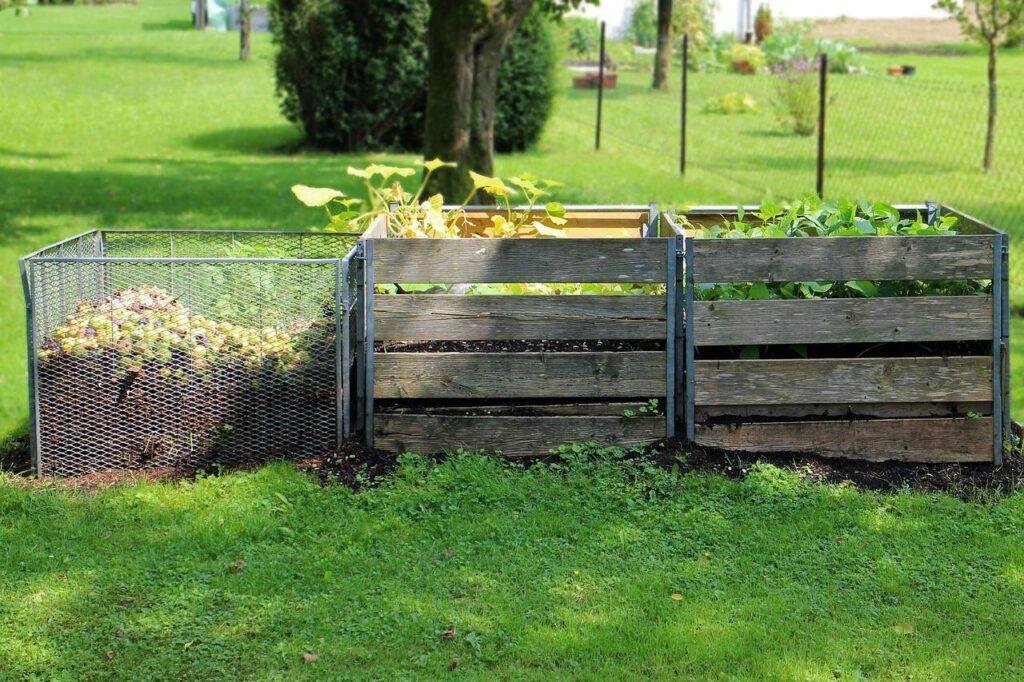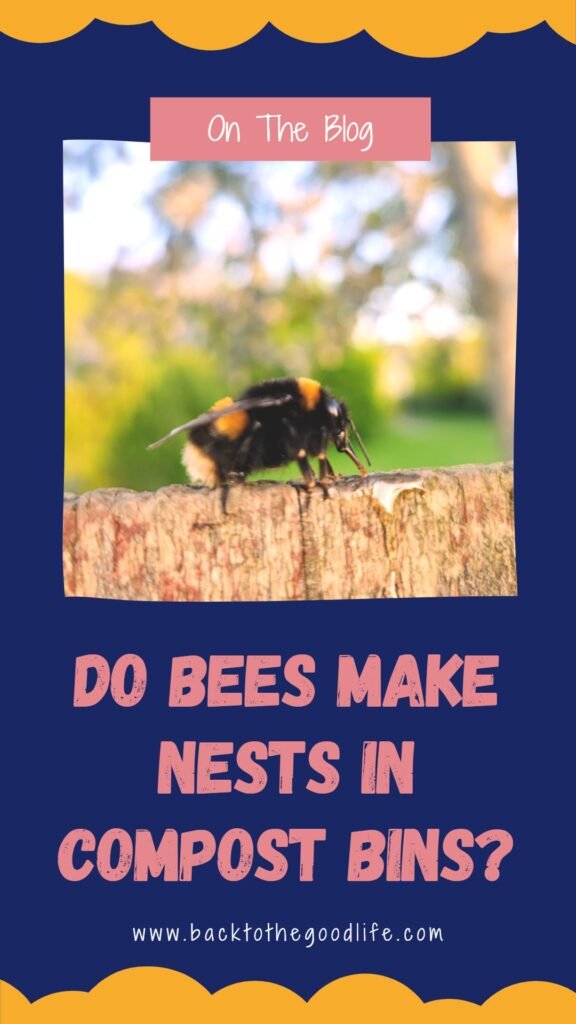Do Bees Make Nests in Compost Bins?
Just a heads up, this post contains some affiliate links. That means that we earn a small commission if you buy the product at no extra cost to you. That allows us to continue to research and share interesting articles with you. :)
Did you know that bees make nests in compost bins? I came across this recently when doing a bit of research about compost bins, that bees can (and do!) actually make your bin their home. As with everything in the garden though, it’s not that simple…

Some species of bees will make nests (or hives) in a compost bin. In a recent study, we found that 67% of gardeners have had encounters with bees or wasps in their compost bins. While it’s not common for bees to make nests in compost bins or compost piles, wasps and hornets are the usual culprits rather than bees, this problem can be a problem for gardeners and homesteaders alike.
Usually, wasps, hornets, or bees make nests in a compost bin or heap because it has been neglected and is quite dry.
Yellow Jacket wasps and European Hornets are more likely to be the culprit of the “bees” you are seeing in your compost bin, and sometimes these insects will see your compost pile, bin, or heap as a good option to live in.
To the untrained eye, a wasp and a bee can look quite similar which is usually where the question of “do bees make nests in compost bins?” come from.
What Type of Bees Live in Compost Bins?
Ground-dwelling bees are the most common type of bees that you will find in your compost heap or bin. While most of the bees in your compost will be ground-dwelling, there are a couple that are more likely to build their homes in your bin.
As mentioned above, Yellow Jackets are not actually “bees” and neither are European Hornets, but are often mistaken for bees by homeowners and gardeners alike.
Bees Vs Wasps: What Is In My Compost Bin?
Yellow Jackets and Hornets are both considered social insects meaning they live in a colony with a queen and workers.
While bees generally do not sting unless provoked, they may nest in your compost bin and can be a real pain to get rid of. This is especially true if you have children or pets in the house; hornets and yellow jackets deserve respect for their stinging abilities!
While the bees can be an irritant, I have found that the hornets are far more aggressive than the bees.

Hornets and Wasps
Hornets are most commonly found in the fall and winter months and can live in a trash can or compost bin.
The hornet is larger than a honeybee at 1 inch long and black with yellow stripes. A hornet can cut through paper and is more likely to sting than a honeybee.
As with all stinging insects, hornets cause pain for about 20 minutes and can be fatal if wasp stings are multiple, right next to each other, or done by a large number of hornets, or if you are at particular risk of a sting bringing on an allergic reaction like hives or anaphylaxis.
European Hornets are thought to have migrated from Asia over a century ago and now thrive in North America. The hornets have adapted to their new continent, finding nesting holes to live in as well as different food sources depending on where they live such as garbage cans, compost bins or bird feeders.
Hornets are quite aggressive when it comes to protecting their nest and will sting if they feel threatened or disturbed by human activity.
There are various different species of wasp, all called ichneumon wasps. There are black, brown, and yellow wasp species found in the U.K., but the most common is the yellowjacket (Vespula vulgaris).
Bees
When it comes to bees in compost bins, there are usually two species of bee that are likely to want to make your compost heaps their home: The ground-dwelling bee and the bumblebee.
Honeybees CAN be found in some compost bins, and it’s not completely rare, but the conditions in the compost pile or heap have to be quite specific for honeybees to make their nest.
The solitary bee can be easily identified by its small size, but at twice the size of a honeybee, it is still easier to mistake them for a wasp, so use extreme caution when working around the compost pile or heap.
Bumblebees are alone of the more common species of bees that make nests in compost bins or compost heap, the solitary Queen emerges in the Spring, searches for food, and returns to your compost heap to lay eggs. She flies in and out for nectar for her brood and, after around a month, you’ll see new bumbles fly out.
In general, bees are quieter and gentler than wasps, they will usually only sting after being provoked, but they can and will sting if they feel it’s necessary.
Bees Vs Wasps – The Differences
There are a number of ways to tell the difference between a bee and a wasp. While these insects do look similar, there are a few key differences you can look out for…
Hornets, wasps, and bees are all pollinators so they have the same goal: to ensure that their species continues to be around in future generations.
While bees can sting multiple times, hornets and wasps cannot and will die after stinging once.
Unlike bees, hornets are more likely to build large nests which can become quite a worry if you have children or pets living in your home.
If you want to know more about these bees and how to recognise them, check out this video:
What Makes A Bee More Likely To Nest In A Compost Heap?
As mentioned above, it’s not usual for wasps or bees to make nests in compost bins, rest assured this isn’t something you’re probably going to need to be worried about as a home gardener, a smallholder, or a homesteader.
Having said that, there ARE some situations that will make your compost pile more attractive to bees and wasps.
If your compost heap is very dry and neglected, this makes a much better environment for a bee or wasp colony to live in than a moist, humid bin. A wasp will also be more tempted to nest in a dry compost heap because they are attracted to the sweet smell of rotten fruit and other sweet-smelling food scraps.
For the most part, you are unlikely to have a problem with bees or wasps in your compost bin if it is used regularly and turned regularly, and if you add lots of different types of materials to your heap or pile.
Compost bins, heaps, or piles without a lid or cover are also more likely to attract wasps and bees. The simple solution to this is to build a compost bin with a lid, not too tight, and to always provide an alternative home for these important pollinators.

Help! I Have Bees In My Compost Bin -What Do I Do?
Have you found a lot of bees making nests in your compost bins? While it’s easy to panic, don’t worry too much. The problem with bees in the compost heap is not unique to the UK or US – many people encounter this problem across the world.
If you find wasps or bees in your compost bin, there are a few things you can do to deal with them safely and effectively.
Build Your Own Bee Hotel
If there really is a bee colony making a nest in your compost heap, it’s best to choose one specific area of your garden where they can build their nest without disturbing the rest of your plants and crops.
Giving them a bee hotel is a great alternative.
Call A Bee Keeper
If you do find bees (rather than wasps) you should call a beekeeper. Don’t try to remove the bees yourself, as this is likely to end in disaster.
There are a lot of beekeepers who will be willing to collect the bees and make sure they’re put somewhere safe so that you can keep composting without having to worry about them for the rest of the season.
Boiling Water
This should ONLY be used if you are certain that the nest is either waps or hornets. Do NOT kill bees as these are protected and vital for pollination.
Go out in the evening time (dusk)and pour boiling water on the entrance to the nest or colony, be sure to pour the water and RUN as this will make the wasps and hornets very angry. Leave it until the morning and hopefully, most of them will have been eradicated.
It should be noted that, in general, we don’t recommend lethal pest control like this for wasps or hornets or similar.
Leave Them Alone
You’ll be happy to know that compost bins aren’t the number one choice for bees or wasps to live in. As we said above, compost bins usually have to be dry and neglected before they will try to nest in them.
The very best advice we have for you if you do find your compost heap has some unwanted buzzing visitors is to just leave them alone.
Of all the gardeners we spoke to when researching this post, almost all of them said they left the bees to it and they were gone within a few months. Honeybees usually move on after a month or so, but ground-dwelling bees can take a few months to leave.
Conclusion

Hopefully, this post has given you a better understanding of what a bee is and how it differs from a wasp, and which ones are likely to live in your compost heap.
In most cases, this is not something you have to worry about. Bees and wasps are not interested in becoming your pets. They are their own creatures that have their own agenda and preferences. In the majority of cases, they are only looking for the best place to call home.
Don’t panic if you find a bee in your compost pile or heap. In most cases, they don’t want to be there any more than you would want them there!
Back To The Good Life is a participant in the Amazon Services LLC Associates Program, an affiliate advertising program designed to provide a means for sites to earn advertising fees by advertising and linking to Amazon.com. We also participate in other affiliate programs which compensate us for referring traffic.







